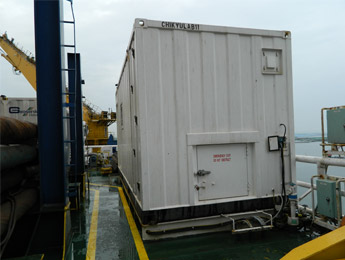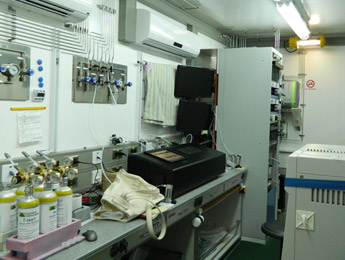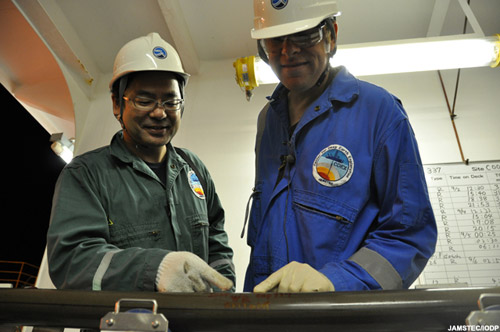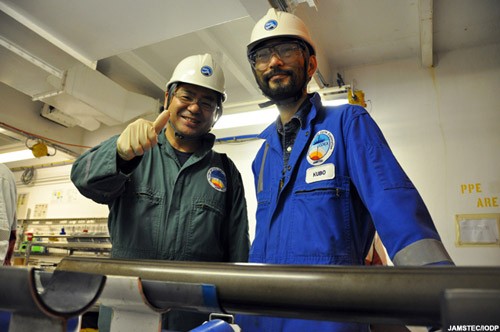Repeat attempt putting nature first
The investigation of the subseafloor forests off Hachinohe and the underground microorganisms using those, had been thwarted by nature many times already. In 2006 the CHIKYU, on shakedown cruise, was forced to cap the hole that was drilled to 511m beneath the sea floor and retreat because of an approaching powerful explosive low pressure system. The CHIKYU naturally has the ability to correctly determine the position of the drill site and drill the same hole again. In fact, Inagaki was supposed to redrill the hole and survey the coalbeds at 2,000m beneath the seafloor in 2011. He came to Hachinohe and started preparing, with a scheduled departure for March 15. Just as the CHIKYU was getting ready, it got caught up in the Tohoku Earthquake of March 11. The continuing aftershocks made the drilling survey impossible, and the expedition had to be postponed. The 2012 attempt is in other words a re-repeat after 6 years.
Amongst the microorganisms living in the layers deep below the seafloor are also methane producers. They breathe in carbon dioxide and breathe out methane. So as long as there are nutritional sources such as coalbeds, there lies the potential for producing fuel by using carbon dioxide. But however good the idea may be, no start can be made without a concrete understanding of the situation deep in the ground.
“This doesn’t mean that we will be actually injecting carbon dioxide. Because we are engaged in the science of earth-life systems, we first need to collect geological samples with its subseafloor status intact and explore the scientific reality of the actual environment,” explains Inagaki. He plans to collect ground water by applying technologies so far used in oil drilling to scientific research, a first in scientific ocean drilling. A new mud gas analysis laboratory has been built on board the CHIKYU for this research expedition. Drilling in areas with high pressure oil gas or in deep subseafloor strata requires a riser drilling system, where artificial drilling mud is circulated between the drill bit and the ship. The laboratory is for the constant monitoring of the return drilling mud for natural gasses and for the supersensitive analysis of geochemical data on things such as chemical compositions and methane carbon isotopes. It is a facility for collecting data that stands up to scientific scrutiny, and the CHIKYU is the world’s only drilling vessel with this class of analytic equipment.
Inagaki passionately described his expectations and outlook: “This is in fact the world’s first scientific drilling survey to drill both deposits containing natural gasses like methane hydrate and the underlying coalbeds. This is an extremely interesting attempt to answer questions as to what kind of carbon cycle system and what kind of biological activity will be found. Understanding that means understanding the ecosystem and the matter cycle of the earth itself. I feel that this drilling survey could give us a clue as to how to solve future environmental and energy problems, and give us a clearer view of a sustainable system where earth and human society can co-exist.
“This doesn’t mean that we will be actually injecting carbon dioxide. Because we are engaged in the science of earth-life systems, we first need to collect geological samples with its subseafloor status intact and explore the scientific reality of the actual environment,” explains Inagaki. He plans to collect ground water by applying technologies so far used in oil drilling to scientific research, a first in scientific ocean drilling. A new mud gas analysis laboratory has been built on board the CHIKYU for this research expedition. Drilling in areas with high pressure oil gas or in deep subseafloor strata requires a riser drilling system, where artificial drilling mud is circulated between the drill bit and the ship. The laboratory is for the constant monitoring of the return drilling mud for natural gasses and for the supersensitive analysis of geochemical data on things such as chemical compositions and methane carbon isotopes. It is a facility for collecting data that stands up to scientific scrutiny, and the CHIKYU is the world’s only drilling vessel with this class of analytic equipment. Inagaki passionately described his expectations and outlook: “This is in fact the world’s first scientific drilling survey to bore both deposits containing natural gasses like methane hydrate and the underlying coalbeds. This is an extremely interesting attempt to answer questions as to what kind of carbon cycle system and what kind of biological activity will be found.
Understanding that means understanding the ecosystem and the matter cycle of the earth itself. I feel that this drilling survey could give us a clue as to how to solve future environmental and energy problems, and give us a clearer view of a sustainable system where earth and human society can co-exist.

- |1|
- 2|




